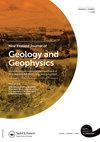Greymouth盆地Paparoa组冲积扇和扇三角洲:一个新的裂谷模型
IF 1.9
4区 地球科学
Q1 GEOLOGY
New Zealand Journal of Geology and Geophysics
Pub Date : 2021-10-10
DOI:10.1080/00288306.2021.1984257
引用次数: 1
摘要
通过对格雷茅斯裂谷盆地西北部砾岩沉积相的分析,确定了晚白垩世至古新世的冲积扇和扇三角洲沉积环境。砾石辫状河相组合被解释为在以河流为主的冲积扇环境中的高能辫状河流。砂质三角洲前缘相组合是由高床质河口坝和河道撕脱作用形成的。砂质前三角洲相组合被解释为扇三角洲斜坡环境中的高密度浊流和水下碎屑流。层理几何表明扇三角洲Hjulström-types形成于较低角度的斜坡上。砾岩厚度由西北向东南逐渐减小,表明主要的盆地边界断裂位于西北近海,极有可能是角风-独木舟断裂带。总体相分布和古流动方向表明,格雷茅斯盆地是在纯伸展环境下形成的半地堑,没有走滑运动。西海岸地区同生次盆地的存在表明它们可能经历了与格雷茅斯盆地相似的沉积历史。我们的发现与塔拉纳基盆地以前的模型一致,即裂谷作用是纯粹的伸展作用,表明西海岸-塔拉纳基裂谷系主要记录正交伸展。本文章由计算机程序翻译,如有差异,请以英文原文为准。
Alluvial fans and fan deltas in the Paparoa Formation, Greymouth Basin: a new rift model
ABSTRACT Sedimentary facies analysis of conglomerate deposits in the Greymouth Rift Basin has identified the latest Cretaceous to Paleocene alluvial fan and fan delta environments on the northwestern side. The Gravelly Braided River Facies Association is interpreted as high energy, braided river streamflow in a streamflow-dominated alluvial fan environment. The Gravelly Delta Front Facies Association was deposited by high bedload mouth bars and channel avulsion. The Gravelly Prodelta Facies Association is interpreted as high-density turbidity currents, and subaqueous debris flows in a fan delta slope environment. Bedding geometries suggest the fan deltas were Hjulström-types formed on lower angle slopes. The gradual decrease in conglomerate thickness from northwest to southeast indicates that the primary basin bounding fault was located offshore to the northwest, most likely the Cape Foulwind-Canoe Fault Zone. Overall facies distribution and paleoflow directions indicate the Greymouth Basin formed as a half-graben in a purely extensional setting with no strike-slip movement. The presence of contemporaneous sub-basins in the West Coast region suggests they likely experienced similar depositional history to the Greymouth Basin. Our findings agree with previous models from the Taranaki Basin that indicate that rifting was purely extensional, suggesting that the West Coast-Taranaki Rift System recorded primarily orthogonal extension.
求助全文
通过发布文献求助,成功后即可免费获取论文全文。
去求助
来源期刊
CiteScore
5.10
自引率
27.30%
发文量
34
审稿时长
>12 weeks
期刊介绍:
Aims: New Zealand is well respected for its growing research activity in the geosciences, particularly in circum-Pacific earth science. The New Zealand Journal of Geology and Geophysics plays an important role in disseminating field-based, experimental, and theoretical research to geoscientists with interests both within and beyond the circum-Pacific. Scope of submissions: The New Zealand Journal of Geology and Geophysics publishes original research papers, review papers, short communications and letters. We welcome submissions on all aspects of the earth sciences relevant to New Zealand, the Pacific Rim, and Antarctica. The subject matter includes geology, geophysics, physical geography and pedology.

 求助内容:
求助内容: 应助结果提醒方式:
应助结果提醒方式:


